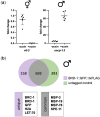Inducible degradation of dosage compensation protein DPY-27 facilitates isolation of Caenorhabditis elegans males for molecular and biochemical analyses
- PMID: 35404452
- PMCID: PMC9073673
- DOI: 10.1093/g3journal/jkac085
Inducible degradation of dosage compensation protein DPY-27 facilitates isolation of Caenorhabditis elegans males for molecular and biochemical analyses
Abstract
Biological sex affects numerous aspects of biology, yet how sex influences different biological processes have not been extensively studied at the molecular level. Caenorhabditis elegans, with both hermaphrodites (functionally females as adults) and males, is an excellent system to uncover how sex influences physiology. Here, we describe a method to isolate large quantities of C. elegans males by conditionally degrading DPY-27, a component of the dosage compensation complex essential for hermaphrodite, but not male, development. We show that germ cells from males isolated following DPY-27 degradation undergo meiosis and spermiogenesis like wild type and these males are competent to mate and sire viable offspring. We further demonstrate the efficacy of this system by analyzing gene expression and performing affinity pull-downs from male worm extracts.
Keywords: Caenorhabditis elegans; DPY-27; Genetics of Sex; dosage compensation; males; meiosis; spermiogenesis.
© The Author(s) 2022. Published by Oxford University Press on behalf of Genetics Society of America.
Figures




References
-
- Boulton SJ, Martin JS, Polanowska J, Hill DE, Gartner A, Vidal M.. BRCA1/BARD1 orthologs required for DNA repair in Caenorhabditis elegans. Curr Biol. 2004;14(1):33–39. - PubMed
